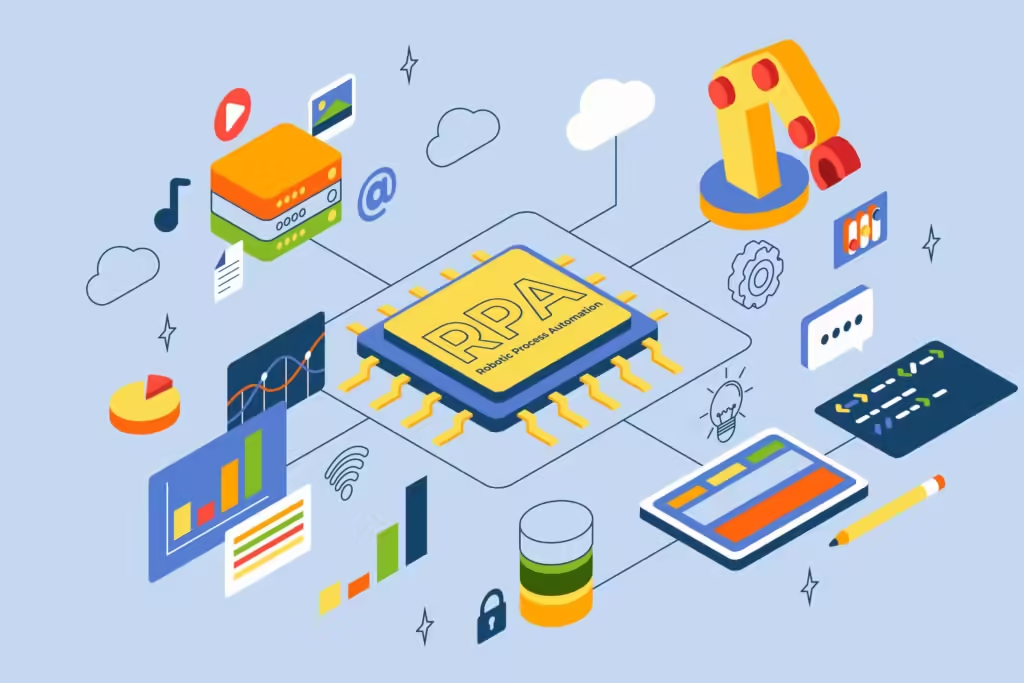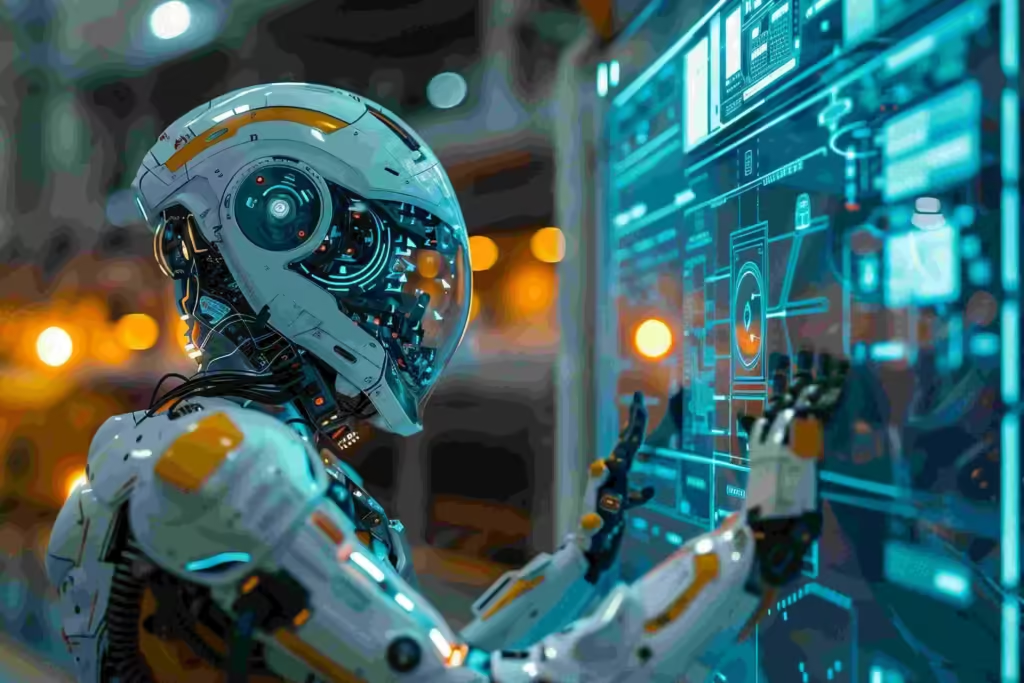In the era of digital transformation, companies are continuously seeking ways to improve efficiency, reduce costs, and streamline operations. One of the most impactful technologies driving this change is Robotic Process Automation (RPA). In this comprehensive guide, we’ll delve into what RPA is, its purpose, how it differs from AI, its use cases, and much more. Whether you’re a business leader or a tech enthusiast, this article will provide you with valuable insights into the world of RPA.
Table of Contents
What Is RPA – Robotic Process Automation?
Robotic Process Automation (RPA) is a technology that uses software robots, or “bots,” to automate repetitive and rule-based tasks that were traditionally performed by humans. These tasks could include data entry, processing transactions, managing records, and more. RPA is designed to mimic the actions of a human interacting with digital systems, but at a much faster pace and with higher accuracy.
RPA bots can log into applications, enter data, calculate and complete tasks, and then log out, without requiring human intervention. Unlike traditional automation, which requires significant coding and system integration, RPA works at the user interface (UI) level, making it easier to implement and more flexible.
What is the Main Purpose of RPA?
The primary purpose of Robotic Process Automation is to enhance the efficiency and accuracy of business processes. By automating mundane and repetitive tasks, RPA frees up human workers to focus on more complex and strategic activities that require creativity and decision-making.


Here are some of the key purposes of RPA:
- Cost Reduction: RPA can significantly reduce operational costs by minimizing the need for manual labor.
- Increased Productivity: Bots can work 24/7 without breaks, leading to a substantial increase in productivity.
- Improved Accuracy: Since RPA bots follow rules precisely, the risk of human error is eliminated.
- Scalability: RPA systems can be scaled up or down easily to match the business needs.
- Better Compliance: RPA ensures that processes are performed consistently and according to regulatory standards.
What is the Difference Between RPA and AI?
While Robotic Process Automation (RPA) and Artificial Intelligence (AI) are often mentioned together, they are distinct technologies with different applications.
- RPA: RPA is rule-based and works by following predefined instructions to perform repetitive tasks. It does not “think” or “learn”; it simply executes the tasks it is programmed to do. RPA is best suited for processes that are structured and do not require decision-making based on unstructured data.
- AI: AI, on the other hand, involves the simulation of human intelligence by machines. AI systems can learn, adapt, and make decisions based on data analysis. While RPA handles tasks that are repetitive and predictable, AI can handle more complex tasks that involve decision-making, problem-solving, and even creativity.
In summary, while RPA automates routine tasks, AI brings cognitive capabilities to the table, allowing machines to understand, learn, and make decisions. Together, they can create more powerful and intelligent automation solutions.
Robotic Process Automation Use Cases
Robotic Process Automation has found applications across various industries due to its versatility and efficiency. Let’s explore some of the most common use cases where RPA is making a significant impact:


1. Finance and Accounting
RPA is widely used in the finance sector to automate tasks such as invoice processing, reconciliations, payroll management, and financial reporting. By automating these processes, companies can reduce errors, improve compliance, and accelerate financial operations.
2. Customer Service
In customer service, RPA bots can handle routine inquiries, process requests, and update customer records, allowing human agents to focus on more complex customer interactions. This leads to faster response times and improved customer satisfaction.
3. Human Resources (HR)
RPA can automate various HR tasks, including employee onboarding, data entry, and benefits administration. This not only speeds up HR processes but also ensures accuracy and consistency in employee records.
4. Healthcare
In healthcare, RPA is used to automate patient record management, appointment scheduling, and claims processing. This helps healthcare providers focus more on patient care and less on administrative tasks.
5. Supply Chain Management
RPA can optimize supply chain operations by automating order processing, inventory management, and shipment tracking. This results in faster delivery times and reduced operational costs.
These are just a few examples of how RPA is transforming industries by automating repetitive and time-consuming tasks, allowing businesses to operate more efficiently.
Cognitive Robotic Process Automation
Cognitive Robotic Process Automation (Cognitive RPA) takes traditional RPA to the next level by integrating AI and machine learning capabilities. While standard RPA is limited to rule-based tasks, cognitive RPA can handle more complex tasks that require decision-making, natural language processing, and data analysis.


Cognitive RPA can:
- Understand and Process Unstructured Data: Unlike traditional RPA, cognitive RPA can process unstructured data such as emails, scanned documents, and voice recordings.
- Learn and Improve Over Time: Through machine learning, cognitive RPA systems can learn from past data and improve their performance over time.
- Make Decisions: Cognitive RPA can analyze data and make decisions based on predefined criteria, enabling more intelligent automation.
For instance, in a customer service scenario, cognitive RPA can analyze customer inquiries, understand the context, and provide personalized responses without human intervention.
What are Examples of Robotic Process Automation?
Robotic Process Automation is versatile and can be applied to a wide range of business processes. Here are some specific examples:
1. Data Entry
One of the most common uses of RPA is automating data entry tasks. For example, a bot can extract data from emails or documents and enter it into a database, reducing the need for manual data entry and minimizing errors.
2. Invoice Processing
In the finance department, RPA can be used to automate the process of invoice generation, validation, and payment. This speeds up the accounts payable process and ensures accuracy.
3. Order Processing
In e-commerce, RPA can automate order processing by handling tasks such as order confirmation, inventory checks, and shipment tracking. This results in faster order fulfillment and improved customer satisfaction.
4. Employee Onboarding
HR departments can use RPA to automate the onboarding process for new employees. The bot can handle tasks such as setting up employee accounts, sending welcome emails, and generating ID cards.
5. Customer Account Management
In banking, RPA can automate the process of opening and closing customer accounts, updating customer information, and processing loan applications. This reduces the workload on human employees and speeds up customer service.
The Future of Robotic Process Automation
As technology continues to advance, the capabilities of Robotic Process Automation are expected to grow. The integration of AI and machine learning with RPA will lead to more intelligent and autonomous bots that can handle increasingly complex tasks. Additionally, as businesses continue to embrace digital transformation, the adoption of RPA is expected to rise, leading to more streamlined and efficient operations across industries.
Moreover, RPA is likely to evolve beyond simple automation to become a key component of broader digital transformation strategies. Companies will increasingly use RPA in conjunction with other technologies such as AI, big data analytics, and the Internet of Things (IoT) to drive innovation and gain a competitive edge.
Conclusion
Robotic Process Automation (RPA) is a powerful technology that is transforming the way businesses operate. By automating repetitive and time-consuming tasks, RPA not only enhances efficiency but also allows employees to focus on more strategic and creative activities. As RPA continues to evolve and integrate with AI, its potential to drive innovation and improve business outcomes will only increase.
For businesses looking to stay ahead in the competitive landscape, embracing RPA is no longer an option but a necessity. Whether you’re looking to reduce costs, improve accuracy, or accelerate operations, RPA offers a solution that can deliver tangible results.
By understanding the capabilities and potential of RPA, businesses can make informed decisions on how to best leverage this technology to achieve their goals. As we move towards a more automated and digital future, the importance of RPA in driving business success will continue to grow.




